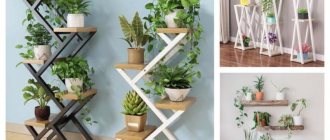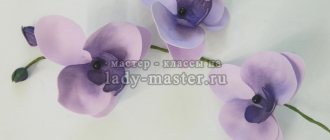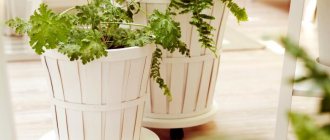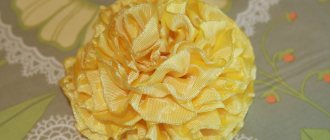A rack with violets arranged near the window. An interesting solution adds natural light and heat from the battery
Violet is a small perennial plant that not so long ago people managed to tame, and now they are successfully grown at home. They are somewhat finicky to care for, but in return they delight the eye with their unusual and colorful flowers.
True connoisseurs of violets are very kind to their pets, take care of a sufficient amount of light and water, “feed” them with special vitamins, and arrange entire flowering islands using illuminated racks for violets. In this article we will talk in detail about how to correctly and quickly build a rack for violets with your own hands.
Making a rack with shelves for violets with your own hands
You can make a rack with your own hands, since it is not that difficult and you can use any materials.
Another plus is that the size of the future rack for violets depends only on you! (make according to your parameters) The most common wooden rack. First you need to buy chipboard boards of the size you need. If there is a need, you need to sand out the flaws with sandpaper, and then proceed with the installation of lighting fixtures and fastening.
Photo of wooden shelving
Another option could be a glass shelving unit. To directly cut the material, you need to resort to the services of craftsmen. The glass must have at least 1.5 cm! To attach such shelves you need to use aluminum profiles, dowels and adhesive pads.
Glass shelving for windows
You can design a mobile rack on wheels. To do this, assemble a frame from a profile or timber, at the bottom of which holes are made for the wheels. Then the wheels are attached and the shelves are installed directly. You can also use your imagination and decorate it as you wish.
Another option would be a metal shelving unit. To do this, you need to have rods with a diameter of 10-15 mm and use a welding machine to create a metal frame. The shelves for such a rack are cut out of wood and fixed to a finished frame. For greater stability, you can additionally attach the structure itself to the wall using self-tapping screws.
Illuminated rack, photo
The choice is yours; it depends only on you what material your design for violets will be made of, what appearance, color, and size it will have.
DIY rack with lighting
To make a backlit rack you will need the following materials: a drill, wooden boards and beams, a level and a tape measure, self-tapping screws and screws, metal pipes, lamps, junction boxes, chokes, starters and several plugs.
It is imperative to collect all the necessary materials, since searching for them may take more time than assembling the rack itself!
Shelving drawing
You need to determine the height of your flower rack before you get started! It is better to immediately make the rack high, so as not to redo it in the future. You need to make a gap of 45 cm between the rack and the ceiling. The width of the shelves depends on the number of lighting fixtures that will illuminate the violets.
Made of wood
You need to start making a wooden shelf with your own hands by purchasing chipboard scraps from the workshop.
Or you can buy a whole sheet and cut it into the desired pieces at the store. Each fragment can be, for example, 15 by 20 centimeters, or maybe narrower. To build a wooden rack for Saintpaulias you will need:
- Chipboard fragments;
- Hammer;
- Drill and screwdriver;
- Drill;
- Shoe knife;
- Adhesive edge – jig and tape;
- Plugs;
- Dowels;
- Glue;
- Canopies, self-tapping screws, euroscrews.
To begin with, chipboard fragments should be pasted over with an edge (for example, using an iron), cutting off excess particles with a knife. Excess can also be sanded off with sandpaper. Some of the fragments - which will be the basis of the shelf for Saintpaulias - need to be pasted over only to the middle. Drill two holes in the un-glued part and drive in dowels using glue. Having done the same with the counterpart, connect them with a “ladder”.
It will take several hours for the shelves to dry. The “ladder” of fragments consists of four elements (vertically). After this, you need to mark the rack for violets, drill holes, screw the cells, screw on the canopies and erase the markings. The heads of the Euroscrews must be sealed. Using self-tapping screws, the original shelf for beautiful Saintpaulias is screwed to a flat vertical surface, for example, to a wall.
Basic rules of care.
How to prepare soil for violets with your own hands and what the composition should be.
Let's consider in more detail the basic rules for caring for violets. Where is the best place to place them, how to water them, what kind of lighting, air humidity suits them, is it worth feeding them?
Lighting.
They do not like direct sunlight, but need bright light. Violets on window sills should be darkened with curtains or solar control film. In the cold season, it is better to place flowers under a lamp.
Violets love direct sunlight
Location.
– window sill on the balcony; – window sill in the kitchen;
It is not worth placing plants in the room, because there will be a lack of light, and therefore it will not bloom.
Balcony is the optimal place for violets
Watering.
The water must settle, and only then watering should be carried out. Rainwater, well water or melted snow will do. All flowers love warm water.
Different options for watering violets.
Top watering. Water is poured into a pharmaceutical bulb or watering can with a thin spout and carefully watered over the outlet.
Watering with a pharmaceutical bulb
Watering into the pan. This method is suitable for a pot that has holes and stands in a flowerpot or tray. Water is poured into the pan.
Watering into a tray
Wick watering. The plant is planted in a pot with holes. A piece of cotton fabric or rope is placed on the bottom, and earth is poured on top. The pot is inserted into a jar or container with water. Water enters the flower through the wick.
Organization of wick irrigation
Air humidity.
Violets love air humidity. To do this, you can take a container of water and place it next to the violets, you can also put a decorative fountain.
Do not spray the plant with a spray bottle. More precisely, it is possible, but only leaves, but it is very difficult to do. Therefore, it is better to use the methods described above.
Feeding.
The variety will grow better, gain foliage, and flowers will appear faster if you feed the flowers with mineral fertilizers.
You cannot fertilize violets with eggshells, banana peels, tea or coffee residues - all this leads to the formation of small midges in the house, which will be difficult to remove.
Mineral fertilizers are available in the form of sticks, powder or liquid fertilizers. They are not very expensive and can be diluted in water.
Violets need regular feeding
It is recommended to bury the stick in the ground, but it is best to also dissolve it in water. For example, powder feeding costs from 6 rubles per bag, which can be divided into several uses.
Transfer.
Violet can grow in one pot for a long time. There are varieties that grow foliage and shoot upward, in which case it is worth changing the pot when the violet does not look aesthetically pleasing, there is too much foliage and flowers, and the pot is small.
Transplanting violets
Earth.
Any soil is suitable for violets, but the best soil is from your own garden plot. It is best to make the ground airy. To do this, cut ordinary polystyrene foam into pieces and mix with soil.
Primer for violets with pieces of polystyrene foam
On the pages of many magazines, you can see that you can add sand to the soil for flowers - this is not suitable for violets. Sand retains moisture, and in violets, excess moisture leads to the death of the plant. It is worth loosening the soil periodically. A kebab stick is suitable for this. After a while, the soil in the pot becomes a little less and it is worth adding new soil on top.
Pot.
The flower pot for violets should be small, because Saintpaulia blooms only in a cramped pot. It may be without holes, but then you don’t need to water or flood the plant a lot. If the plant needs to be replanted, but there is no pot at home, then an ordinary plastic cup, yogurt or dessert container will do.
Violets bloom only in a cramped pot
For a young plant, a pot up to 6 cm in diameter is suitable.
Old dried flowers and leaves should be removed from the plant. Trim them with scissors, pruning shears, or simply tear them off. The lower edge of the leaves should be removed, then the plant will flower faster. If you have varietal violets or so as not to forget the color of the future violet, insert an ice cream stick, spatula and write the variety with a marker. Or glue a piece of paper with the name to the cup.
Old dried leaves should be removed from the plant
Subtleties of choice
When there is a desire to decorate your home with stylish and beautiful shelves for flowers, many are lost when choosing (due to its diversity). Indeed, both creative and classic sets are presented on store shelves. A few tips can help you make your choice.
It is also important to consider cost. To create a beautiful window treatment, you don’t have to invest a large sum. You need to start from functionality and external aesthetics, and not overpay for the brand name. When you have experience working with metal or wood, you can make flower stands yourself.
It is also important to take into account the number of products: the more unusual the shape and design, the fewer shelves there should be (and vice versa). In addition, it is worth starting from the purpose of a particular room: it is no secret that the atmosphere of the kitchen, living room, bedroom and study is different. So, a certain enthusiasm is welcomed in the kitchen. Smooth lines and openwork elements are appropriate in the bedroom. In the living room you need to show the uniqueness and unusualness of the configuration. If you want to decorate the window sill of your study with a flower shelf, you should choose a simple product without frills.
When shelves are purchased to decorate the windows of verandas or closed gazebos, a different situation arises: you can buy luxurious forged structures, creating the illusion of a design ensemble. When there is only one window, they are allocated a specific functional area. For example, accenting bay windows with flower shelves will create the feeling of a greenhouse.
Making a rack with shelves for violets with your own hands
How to make a flower shelf with your own hands
You can make a rack with your own hands, since it is not that difficult and you can use any materials. Another plus is that the size of the future rack for violets depends only on you! (do it according to your parameters)
The most common wooden rack. First you need to buy chipboard boards of the size you need. If there is a need, you need to sand out the flaws with sandpaper, and then proceed with the installation of lighting fixtures and fastening.
Photo of wooden shelving
Another option could be a glass shelving unit. To directly cut the material, you need to resort to the services of craftsmen. The glass must have at least 1.5 cm! To attach such shelves you need to use aluminum profiles, dowels and adhesive pads.
Glass shelving for windows
You can design a mobile rack on wheels. To do this, assemble a frame from a profile or timber, at the bottom of which holes are made for the wheels. Then the wheels are attached and the shelves are installed directly. You can also use your imagination and decorate it as you wish.
Another option would be a metal shelving unit. To do this, you need to have rods with a diameter of 10-15 mm and use a welding machine to create a metal frame. The shelves for such a rack are cut out of wood and fixed to a finished frame. For greater stability, you can additionally attach the structure itself to the wall using self-tapping screws.
Illuminated rack, photo
The choice is yours; it depends only on you what material your design for violets will be made of, what appearance, color, and size it will have.
DIY rack with lighting
To make a backlit rack you will need the following materials: a drill, wooden boards and beams, a level and a tape measure, self-tapping screws and screws, metal pipes, lamps, junction boxes, chokes, starters and several plugs.
It is imperative to collect all the necessary materials, since searching for them may take more time than assembling the rack itself!
Shelving drawing
You need to determine the height of your flower rack before you get started! It is better to immediately make the rack high, so as not to redo it in the future. You need to make a gap of 45 cm between the rack and the ceiling. The width of the shelves depends on the number of lighting fixtures that will illuminate the violets.
The first thing to do is to mark the height on the wall with a pencil - 40 cm from the floor. Then, above this mark we mark 4 more points at a distance of 40-45 cm. This is done in order to see where our shelves will be located.
Then you need to cut the slats and crossbars. If these are metal strips, then you should measure and cut them in advance in workshops.
Where the planks and posts intersect, we make holes and fasten them together.
To assemble the shelf, we need to cut out 3 racks and 1 support, which will only be auxiliary, which we will then remove.
The next step is to attach the slats to the stand and crossbar and fasten them with self-tapping screws. For greater strength, we can coat the part with glue. We fix the shelves in the same way.
LED lighting for a violet rack, video:
Before you begin installing the rack, you should drill holes for electrical wires in the shelves and back wall. To prevent the light from the lamps from blinding your eyes, you should install a partition on the front of the shelves. Then you need to drill holes for the hooks on which the lamps will be attached. We fix the hooks on the shelf and attach the lamps to the holes in the back. Several lamps can be brought out into one plug and connected through a carrier.
We will spend no more than 4-5 hours on the entire frame assembly. But your plants will be provided with a sufficient amount of light, and you will be able to water and fertilize them without any problems.
Watch the video: DIY illuminated violet rack
Varieties of violets
Violets, as indoor flowers, were already in Europe at the beginning of the 19th century, and they were brought from East Africa, which is considered the birthplace of violets.
Today, there are dozens of types of violets, which are not difficult to find and purchase. They are different from each other, but at the same time so beautiful and unusual. They appeal to both experienced gardeners and amateurs who admire them at home.
Varieties of violets differ among themselves: in size (standard, giant or miniature), leaf color (from light green to rich dark green), type of petals (regular, double, semi-double), leaf shape (round, oval, with smooth and uneven edges ), the shade of the flowers (solid, unevenly colored, purple, pink, blue, etc.), the shape of the flowers (classic, star-shaped, star-shaped bordered).
Dimensions
The dimensions of the rack will depend on the number of plants that will subsequently be placed on the shelves and on the placement location.
On the windowsill, the height of the structure will correspond to the height of the window opening, the same must be said about the length of the shelves and their width. The height and width of the rack installed against the wall can be adjusted as desired. The structure can be as high as the ceiling, but at the same time take into account the moment of caring for flowers: how convenient it will be to carry out watering and fertilizing procedures.
The distance between the shelves varies from 40 cm to 50 cm. When measuring the required size, you need to take into account the height of the growing violet bushes and the height of the artificial lamp above them.
Plastic shelves
DIY flower shelves 230 photos: floor, wall, corner, window sill
This method of arranging shelves can be done with brackets or chrome-plated metal tubes. The installation process is quite simple; holes are drilled in the shelves for pipes that serve as racks. The shelves are pulled together with special holders, so the height can be adjusted. And the pipes themselves are attached to the ceiling and floor, just like in a bus. The main thing here is to secure it firmly and drill the entrance holes evenly; there are no more tricks on how to make shelves.
There are many ways and options, it all depends on you and your fantasies, and, of course, possibilities, do not forget that violets do not like darkness, so in dark places you need to make shelves with lighting, good luck to you.
Source
How to ensure a comfortable existence of a plant in winter?
Flowerpots standing on the windowsill in winter are vulnerable. For their comfortable existence, it is necessary to provide them with warmth, for this they use different methods:
- insulation of the window sill - a large share of the cold from the window sill, so the pots are placed on a hill or insulation is laid under them;
- increasing the distance from the glass - the further away the violet is, the lower the risk of hypothermia from cold glass;
- placing Saintpaulias on windows without vents or insulating the vents to avoid drafts, which are very harmful to this species;
- To minimize the possibility of hypothermia, watering is carried out only with warm water.
In winter, the window sill should be insulated.
Advice! The temperature is not lower than 16 degrees, a prerequisite for a good wintering of violets. By providing proper care during this dangerous period, you can minimize the likelihood of illness and preserve your collection as much as possible after winter.
Reminder for a newbie!
Uzambara (Uzumbar) violet is a plant of the Gesneriaceae family, growing in the natural environment of tropical and subtropical regions of Asia, Africa, Eastern Australia, South America and the Indian Ocean islands.
Saintpaulia is a plant named after the Saint-Paul father and son, who brought a plant unknown to Europeans from the Uzambara district (modern Tanzania) in the 19th century, presented for the first time at the international flower exhibition in Ghent in 1893.
Indoor violet has been one of the most popular plants in indoor floriculture since 1927. By 1949, more than 100 varieties had been bred, and today their number exceeds several thousand.
Rooting
- possibly in water, in substrate, moss.
Priming
- purchased soil or a mixture of leaf, coniferous, turf and peat soil in a ratio of 3:1:2:1 with the addition of raising agents (perlite, vermiculite, river sand, crushed sphagnum moss.
Lighting - it is best to place flower pots on western or eastern windows. To ensure that the plant is evenly illuminated from all sides, the pots are periodically rotated. In winter, when daylight hours decrease, you can use artificial lighting - fluorescent lamps.
Caring is a real art and serious painstaking work at the same time, including watering, fertilizing, and creating a favorable humid climate. Water Saintpaulias as the soil dries. The soil must be moistened regularly, but excess moisture should not stagnate in the roots. When watering, you must ensure that water does not get on the leaves. You cannot water the Uzambara violet with cold water. Fertilizing is done with complex mineral fertilizer once every two weeks. Saintpaulia reacts negatively to a lack of nitrogen in the soil. Optimal air humidity is approximately 50%, temperature is 20-22 ° C, without sudden fluctuations and drafts. The leaves of the plant should not touch the window glass. Removal of faded flowers and damaged leaves is carried out regularly.
Reproduction - planting a leaf cutting, part of a leaf, or a daughter rosette. The most popular method is rooting leaf cuttings. The formation of roots and the development of children lasts 4-8 weeks.
Pests are one of the gardener's problems. There are many different types of pests and it is very difficult to classify them. Among Saintpaulia pests, several groups can be distinguished: mites (spider mites, flat mites, transparent mites, etc.), insects (aphids, thrips, springtails, poduras, scale insects, whiteflies, scale insects, etc.), worms (nematodes).
Diseases - distinguish between infectious (gray rot, powdery mildew) and non-infectious diseases (rotting of the stem and root, wilting of the lower leaves, yellowing, leaf spotting, incomplete opening and premature drying, falling of flowers) of plants. The causative agents of infectious diseases are bacteria, fungi, and viruses. To prevent infectious diseases, you should strictly observe the regimes of watering, temperature, humidity, and lighting. Non-communicable diseases usually arise due to poor agricultural practices. They may appear in one instance and not spread to others.
People who communicate with us are: Moscow, St. Petersburg, Novgorod, Omsk, Krasnodar, Yekaterinburg, Voronezh, Kazan, Samara, Togliatti, Novokuznetsk, Astrakhan, Volgograd, Vladimir, Bryansk, Izhevsk, Irkutsk, Ufa and rep., Chelyabinsk, Chita, Yaroslavl , Kaluga, Sochi, Orel, Orenburg, Penza, Perm, Rostov, Ryazan, Saratov, Smolensk, Syktyvkar, Tver, Novosibirsk, Tula, Tyumen, Krasnoyarsk, Ulan-Ude, etc.
CIS countries, Belarus, Ukraine, USA, Germany, Latvia, Moldova, Kazakhstan, Russia.
Forum | Let's consider everything: reproduction and care at home, master classes. Let's discuss home (indoor) types - help, advice: how to do it right, what's best.
“Violets without borders” – 2011-2019
Mobile
Mobile racks for violets are called floor racks on wheels. This is the most convenient type for small indoor plants that require a careful approach to lighting depending on the weather and time of year. To make it you will need:
After completing the required drawing, markings are applied to the plywood. A special frame (two) is assembled from a timber (or profile), fastened with screws and tenons. Shelves intended for Saintpaulias must be cut out according to the markings. For racks, grooves are made in them. If desired, the rack can be painted in any color and left to dry.
The blocks for the wheels are attached to the frame. This is all painted too. Then the wheels should be screwed on and the shelves should be secured. There can be from two to five levels in a Saintpaulia rack. It can be moved to the window, to the wall, into the shade or, conversely, closer to the light. For picky violets, this is the most acceptable design - mobile.
Source
Flower beds on brackets
Flower beds on brackets most often mean twisted stands with holes for flower pots. They are often made in the form of decorative compositions, and thus are a good addition.
Using self-tapping screws, you can also attach several brackets to the facade of the house and place decorative flower pots on them.
One of the most obvious disadvantages of a flower bed on brackets is its massiveness. That is, such a design will look decent in the garden and complement the exterior, but in a confined space such a composition will look too bulky and inappropriate.
Materials
Flower stands can be made from several types of materials.
Tree
Wood is considered the most environmentally friendly material. In addition, the wood can be painted in any color or simply varnished, highlighting the beauty of the natural material. Using special tools, beautiful designs and ornaments are carved into wood.
Chipboard
Chipboard is considered one of the easiest to process and cheapest materials for making flower stands. The slabs themselves can vary in thickness, length and design. Other advantages of chipboard as a material for shelves include ease of maintenance, durability, and variety of materials.
Metal
Metal is often used as a frame part of the structure in flower stands with shelves made of other materials: glass, plastic, chipboard. It can also act as a monomaterial in products.
Forged metal stands look especially beautiful. Such models are considered stronger than others and can withstand a larger number of flower pots. The forging technique provides great opportunities to create products in the form of flowers, chariots, strollers, bicycles, and beautiful twisted masterpieces.
Plastic
Plastic flower shelves are one of the most budget-friendly options for equipping a home or apartment. They come in a variety of colors and shapes. Shelves for flowers made of plastic are not afraid of water. They can be safely used in places with high humidity. They are also easy to care for by wiping with a damp cloth.
Popular articles Thuja in the Urals: how it grows, care, growth conditions
The weight of such shelves is small and is perfectly supported by the walls, so they are used on walls that have a certain load limit.
Rattan
Rattan flower stands become a real home decoration. Rattan can be natural or artificial. Natural rattan is the peeled and dried stems of tropical palm trees. The length of these stems can reach 300 meters. They bend easily and can be used to create any shape. The beautiful weave is made from a strong core of split stem, thanks to which the shelves do not sag or change their shape. Finished rattan products are braided with leather, bark or varnished.
Artificial rattan is an innovative material obtained by extrusion, that is, pressing thermally softened synthetic raw materials through holes of a certain size. Using this technology, strips with imitation of tree bark, round rods, and flat textured strips are obtained.
Glass
Glass shelves for flowers are suitable for any interior. Wide possibilities for creating the shape of the shelf help create the outlines of a specific interior. They can be round, oval, square, rectangular. Both high and low shelves for one or several flowers are made of glass.
For the manufacture of floral designs, transparent and frosted, colored, tinted glass is used. In order to extend the service life of glass, it is tempered.
As a rule, other materials are used in the manufacture of glass shelves: metal, plastic, wood. In general, such tandems make the structure stronger.
Making a shelving unit for the windowsill
Having initially calculated the number of floors of the rack (in our case there will be 4) and its parameters, we proceed to construction. For simplicity and convenience, we take ready-made furniture panels in the size of the window sill, 1200 mm by 200 mm long. For the side racks we install furniture panels 1500 by 200 mm long. We fix it using the format. The height of the shelf in our case is 350 mm. If desired, for greater stability, the structure can be additionally secured to the slope or frame. You can make a rack for seedlings with lighting by attaching lighting to a ready-made structure.
Why do seedlings need lighting?
In winter, plants especially lack natural light. As a result, photosynthesis proceeds sluggishly, normal development and biomass growth slows down. The lack of light is compensated by installing artificial lighting. In stores you can buy lamps of various designs and powers. But how many lamps and what power is suitable for growing plants? First, let's decide which lamps are suitable for lighting.
Choosing the right lamp for seedlings
Suitable for illuminating seedlings:
- Incandescent lamps (17 Lm/W) are a simple, affordable, but not the most effective way of lighting. They provide little light and heat up a lot.
- Fluorescent lamps (70 - 100 Lm/W) type LBT or LB daylight with low power. Provide cold light. Have a low proportion of red light.
- LED (80 – 110 Lm/W) – durable, economical lamps. With them it is easy to select the required spectrum and intensity.
- Sodium metal halide lamps (up to 100 Lm/W) are easy to use, economical, efficient, but they lack the blue spectrum.
- Domestic sodium gas-discharge lamps (200 lumens per watt) emit a yellow-orange glow that does not cause eye irritation. Requires additional installation of a control device.
- Mercury. They have the largest “cross section” in the area of daylight.
- Phytolamps are economical, environmentally friendly, efficient, compact and durable. The most popular for lighting seedlings. Even close proximity of such lighting will not lead to leaf burns.
- Others: halogen (25 Lm/W), linear (47 – 93 Lm/W), xenon gas-discharge lamps (100 Lm/W), neodymium.
In order to illuminate a shelf 50 cm wide and 140 cm long, it will be enough to install a “warm” lamp and a “cold” spectrum lamp with a power of 36 W. And it is best to make up for the lack of sunlight with fluorescent lamps or special phytolamps. Reliable and efficient sodium gas-discharge lamps will also help illuminate racks for growing seedlings.
Recommendations for organizing lighting
Regardless of the type of lighting chosen, try to place the seedlings on a south-facing window. For greater effect, you can install additional reflective screens on the sides and back of the seedlings. The lighting intensity is selected individually for each plant. Depending on the requirements of the plant, the intensity can be adjusted by increasing or decreasing the distance from the lamps to the plant.
Installation instructions
The safety of plants depends on the reliability of the fastenings and the stability of the stand. It is easy to assemble the structure:
- Side metal profiles or corners are attached to the racks of the metal structure using a welding machine, onto which the shelves are then installed.
- The side jumpers are bolted to the metal profile racks. After assembly, shelves are installed on them.
- The wooden frame is assembled and fastened with bolts or screws. Metal corners can be used as fastening elements. Also, the shelves are installed on jumpers pre-fixed on the racks.
- The assembled structure is fixed with brackets, securing one side to the wall, the other to the shelf. Use a drill to drill the required number of holes (usually two for each fastener).
- Lamps are installed on the assembled structure - the rack is ready.
Metal carcass:
Metal profile frame:
A stand for indoor violets will greatly facilitate their placement and maintenance. To make a structure you do not need to have any special skills. The main thing is to think over the shape in advance, choose the material of manufacture, prepare the necessary tools, take into account the size of the plants and the availability of caring for them on the future rack.
Illumination for violets, what to use
There are many different lighting options for indoor plants. The most suitable lamps for violets are fluorescent.
It is most practical to choose such lamps of standard sizes: 26 mm in diameter and 59 cm in length. The average power is suitable - 30 W. Although for young plants you can use 18 W.
The radiation of one standard fluorescent lamp is enough for an area of approximately 1 m². Hang the lamp at a height of 20-25 cm from the violet bushes. It is advisable that the lamp shines from above, and not from the side.
You need to turn on the artificial light source for violets for 12 hours. Some people use special switches with a timer, when the lamp goes out and comes on at the same time automatically, which is very convenient.
LED strips are also effective. They are convenient to attach to any surface in any position. In addition, they are very energy efficient. The only negative is their cost, which is quite high.
If you are seriously passionate about growing Saintpaulias and grow them not only for yourself, but also for sale, then backlit racks for violets would be an excellent solution. The lamps are immediately mounted on the shelves on which the pots are placed.
If you know little about electricity and carpentry, it is better to order such a rack from professionals. Design, size, number of shelves - all this is done at your discretion
When assembling such a structure, it is important to take into account electrical insulation, because the plant will be regularly watered
Tips for placing violets on racks with lamps
- The optimal height between shelves is 45 cm.
- For varieties of violets that bloom with red flowers, there are special phytolamps that have a specific emission spectrum that allows you to obtain many shades of red. Such lamps are installed as additional ones.
- You need to gradually transfer violets to artificial light: first turn on the lamps for an hour, then increase this time by 15-20 minutes day after day.
- Types of violets whose leaves are dark and denser are best placed in the center of the shelf; they need a little more light.
- The temperature on the upper shelves is always slightly higher than on the lower ones. Place young bushes on top, they will be more comfortable in the warmth.
Do not forget that lighting for violets is the most important condition for their existence. Without light, many processes in the plant will go out, it will not bloom and may soon die. If you have a fairly free meta on the window sills, then try to place Saintpaulia on the server or eastern side.
A rack for violets with lighting is the best solution for all lovers of these wonderful flowers. After all, indoor violets, no less than other plants, need good lighting, but cannot tolerate direct sunlight, so natural window lighting is extremely rarely suitable for them. More or less, a northern, northwestern or northeastern window sill, which is illuminated mainly by diffused sunlight, may be suitable for them. Of course, there are some tricks for placing plants on south-facing window sills. For example, curtaining it to the middle with a cloth is not scary if the rays of the setting sun fall on the flowers, but it is best to protect the fragile leaves and flowers of Saintpaulia from the burning rays of the day, which means you will have to block the access of sunlight to the room. Which is not very comfortable.
Daylight hours for a homemade violet should last 13-14 hours, and if you manage to organize additional lighting for it in winter, it will bloom tirelessly even in the February cold. This is why you should buy a shelving unit with lighting. Even distribution of light will make the plant more neat, symmetrical and attractive. It will also significantly increase the number of flowers and the duration of flowering of the plant.
We have prepared racks with automatic lighting for you. In the light of which your violets will feel great! With lighting power: 300 W per 1 m2.
In our online store you can choose a rack for violets.
Lighting organization
If there is not enough lighting for flowers during the day, it can, and even needs to be created artificially. To do this, you can use ice lamps, fluorescent lamps and other devices.
in autumn-winter period
This is especially true for violets, since lack of lighting affects their development almost immediately. But sources of artificial light have a beneficial effect on them, since Saintpaulias have no intolerance.
If the flowers have wilted leaves or peduncles have stretched out, artificial additional lighting will also be very useful.
How to choose the right lamps?
Ideally, plants should be illuminated with lamps and fluorescent lights. The lighting should be white or slightly yellowish. Also, instead of conventional lamps, you can use lighting units that are recharged from the mains and last much longer.
The problem of lack of lighting for saintpaulias on glass shelves can be easily solved by attaching an LED strip to the bottom of the shelf.
Calculation of required lighting
The lighting required for violets is calculated based on the length of daylight hours. Usually it is direct sunlight from the morning until 10.00, as well as from 16.00 until sunset. The rest of the time, diffused light is recommended for violets.
When it is difficult to comply with natural lighting conditions, artificial light sources are used.
Examples of location and mounting of lamps
Lamps for additional lighting are best mounted in twos, maximum three on one shelf. Metal structures are most suitable for mounting such lamps.
In this case, the distance between the shelves should be at least 20-22 centimeters so that the heat from artificial lighting does not harm the plants.
Lamps placed too close can burn the violets.
LED strips are also often used to illuminate violets that are on glass shelves. Such a device not only provides the necessary lighting to flowers, but is also an interesting decorative solution for any room.
Stands for violets on the windowsill
Industrial production
A flower stand for a window sill can be made of different materials, many of them are created not to increase the number of violets placed, but for beauty.
Metal
Purely metal shelves, for the most part, are forged products that serve more of an aesthetic than a practical role.
Forged stands for violets (photo for example).
Often such stands can rightfully be called a work of art, but such options are made to order and are quite expensive. They also exist for general sale; they are simpler, but also look beautiful.
Tree
Wooden stands are more like shelves. Often shelves are made mixed from metal and wood. This type of stand can also be decorated very beautifully; carving and burning are often used, and the shape of the shelves itself can be unusual.
The stands can be arranged in the form of a slide or regular shelves.
Wooden stand in the form of a double-sided slide.
Plastic
Plastic ones are considered the cheapest; they do not offer much variety, but are convenient and practical to use. Plastic shelves are basically shallow baskets on plastic or metal bases.
This type of shelf is well suited for children, and for containing a large number of violets with artificial lighting, less often in natural light.
Plastic stands based on plastic tubes.
Some stands are designed to accommodate as many places as possible for violets. One such option is different racks for vertical placement.
Racks for violets on the windowsill are mostly made of metal, plastic and wood. The number of seats depends on the height of the rack and the order in which the placement points are placed.
Proper placement of such stands will reduce the space required to contain the largest possible number of individuals.
Own production
Wanting to save money, many gardeners make shelves themselves. Among the most common options are shelves made of wood, glass and plastic.
Wooden
Like store-bought ones, DIY violet stands made of wood usually look like simple shelves. To make them, you need bases (metal corners or wooden beams, maybe even boards) and boards for shelves.
As an addition, you can decorate the shelf by burning, decoupage, decorative painting or any available methods. The manufacturing sequence is simple:
- Knock down a base from boards or beams;
- Cut shelf boards to size;
- If desired, decorate or simply paint the bases and shelves;
- Place the shelves on the bases and secure them if necessary.
Glass
Shelves are usually constructed from glass with metal bases made of pipes or corners; sometimes plastic pipes are used. These shelves for violets on the windowsill are quite easy to assemble with your own hands:
- Measure the dimensions of the required glass;
- Cut or order glass;
- Depending on the base, holes are cut in the glass for pipes;
- If the base is made of corners, they need to be welded, but there is no need for holes in the glass;
- The shelves are assembled using special fasteners, or the pipes are cut into pieces, and thin tubes are inserted between them, which are threaded through the glass holes.
Glass stand.
Glass stands look more aesthetically pleasing, but heavy pots cannot be placed on them, and you should also be careful when placing Saintpaulias on wick watering, because this is additional weight
Plastic
Shelves made of plastic are made just like shelves made of wood. Often the bases for them are made of metal or plastic (pipes or corners). The shelves themselves are made of plastic plates, grids or shallow drawers.
The manufacturing procedure corresponds to the chosen base, and completely repeats the sequence of one of the first options.
Advantages and disadvantages
It is worth noting the advantages of shelves for flowers on the windowsill.
- They are original. Any design is distinguished by its shape and is able to convey the tastes of the home owners.
- Flower shelves allow you to create a composition of plants.
- These coasters are unique. They can be used for flowers, seedlings, and sometimes as organizers.
- They are comfortable. Often, such products allow you to place flowers without having to adjust the size of a specific pot.
- The stands are variable. If desired, you can choose a design with holes or a solid working surface.
- Models vary in size. The buyer has the opportunity to purchase stands for specific window measurements.
- Products differ in color. This allows you to buy a suitable option to suit your preferences (or to match the existing furniture).
- They are available. Today they can be bought in many stores, which simplifies the purchase and allows you to choose the option you like.
- Models differ in price. If desired, the buyer can update the design of the window sills with new (cheaper or more expensive) products.
Popular articles Eschscholzia flowers - planting and care in the garden
The disadvantages of such structures are associated with a decrease in the amount of light entering the room when they are used. As a rule, any design prevents the sun's rays from filling the room with light in the required volume. Therefore, in rooms with windows on the north side, such shelves are not always appropriate. In addition, multi-tiered options for windows are not the right solution. They visually change the perception of the interior composition and create a heavy atmosphere in the room. Some varieties are aimed at strict functionality, which is why they sometimes look ugly.
Backlight Features
One of the most common problems that violet lovers have to face is the lack of sunlight. Lack of lighting can lead to the following consequences:
- growth slowdown;
- lack of flowering;
- poor development.
To avoid the above potential problems, it is necessary to resort to additional illumination of the plant. LED strips are perfect for this function. It is recommended to choose a tape whose color spectrum will be cool shades, and the power will not exceed 25 watts per 1 meter.
Consider also the fact that for the rapid development of violets, up to 14 hours of daylight are needed. The LED should be turned on several hours before sunset. This feature allows you to use additional light if your plants are located on a window sill. This type of lighting will not cause discomfort to the eyes and will create comfort in the home.
Another type of lamp that could serve as additional lighting is a fluorescent lamp. If your plants are located not on the windowsill, but on a shelf, then just such a lamp will be convenient to use. The strength of such a lamp is its ability to evenly distribute light over a fairly large radius, which other types of lamps cannot boast of. As a rule, fluorescent lamps are placed above the flowers at a short distance. Most often, most people choose this option.
Organization
If flowers are grown in a dark room, the role of selecting the spectrum of the light flux becomes even more important, since the lamp becomes the main and only source of light for flowers placed in such growing conditions. The speed of development and duration of the growing season of Saintpaulia will depend on your use of the spectrum.
If there is no daylight in the room where violets grow, you should resort to using full artificial lighting. Phytolamps will help you cope with this. Thanks to their purpose, they emit the necessary colors (red and blue) to completely saturate the plants with light. The power of such lamps depends on their length. Thus, a phytolamp with a length of more than 90-120 cm has a power of 36-40 watts.
If you want to achieve healthy and vibrant color in your violets, then purchasing a wide range of lamps is an excellent solution. Under them, the plants will look great and become neater. In this case, it is better to give preference to German companies. Almost all types of lamps from German manufacturers include a full range of spectra. The main characteristic feature of such lamps is the ratio of the shades of the rays.
Quite often, the color of plants that are under phytolamps is perceived by human vision in distorted light. This occurs due to the presence of a small amount of green rays in the spectrum of lamps of this type. To avoid such a problem, it is necessary to resort to combined artificial lighting. Typically, fluorescent lamps are combined with phytolamps.
Whatever types of lamps for violets you choose, a timer relay will help make the task of organizing correct and high-quality lighting easier. Thanks to this device, you can control the duration and frequency of light.
To see how easy it is to solve the issue of illuminating violets, see the video below.
How to make money on violets?
To make money on violets, you first need to read the care information and then buy it. Let's consider the cost of violets and where can you buy them?
Price.
The price for 1 small bush of blooming violet is about 300 rubles. Price for Moscow and Moscow region. On specialized forums and free classifieds sites you can find leaves or leaves with roots, as well as children for less.
Where to buy violets?
– flower salon or flower tents; – flower exhibitions;
Flower exhibitions are held periodically in all cities. Entrance to them is paid, but you can see the whole variety of flowers and even buy them for yourself or as a gift. There are pavilions where flowers are always sold.
Violets can be bought at the exhibition
Is it possible to make money from violets? Let's try!
We buy several flowers with different shades of colors from the store. At home we propagate flowers using any option convenient for you described above. Place in jars, place in a sunny place or under a lamp.
People who breed professionally have special racks and long lamps so that violets delight in flowering.
Rack with lamps for growing violets
After a while there are blooming violets, what to do next?
We take a camera and take pictures. For beauty, we decorate the violet with beautiful packaging, put a butterfly on a stick or use other decor. We design it, place it in a beautiful interior and shoot it in good lighting.
No need to add various filters to your photo. The buyer wants to see exactly the same violet that he saw in the photo. Filters can change the color scheme.
Post beautiful photos of your violets
We transfer photos from the camera to the computer. We are looking for special forums, groups, looking at what prices similar violets are sold at and posting photos. There are special applications for mobile phones. Under the photo we make a competent description: price, color, variety (if the violet is varietal), meeting options.
If you set the price a little lower than others, then the chance that your violet will be noticed and purchased increases significantly. Another option is looking for a store, tent, market that will take flowers for sale
We discuss prices in advance and keep records in a special notebook. After the sale, the seller calls and says that you can come and make a profit for the flower
Another option is to look for a store, a tent, or a market that will take flowers for sale. We discuss prices in advance and keep records in a special notebook. After the sale, the seller calls and says that you can come and make a profit for the flower.
You can give violets to the store for sale
This system of cooperation is beneficial for many flower growers, because they do not invest money in purchasing flowers.
Light mode
We won't go into technical details in this article. Let us only emphasize that Saintpaulias are very sensitive to lighting conditions. They need additional insolation 12 hours a day. If you want to get a strong plant with bouquet flowering for the exhibition, you need to temporarily increase the period of artificial lighting to 15 hours a day: this should be done gradually, increasing the time by one hour per week. It is important to follow the regime; the lamps must be turned on at the same time. Doing this manually is not always convenient, so you need to take care of timers in advance.











